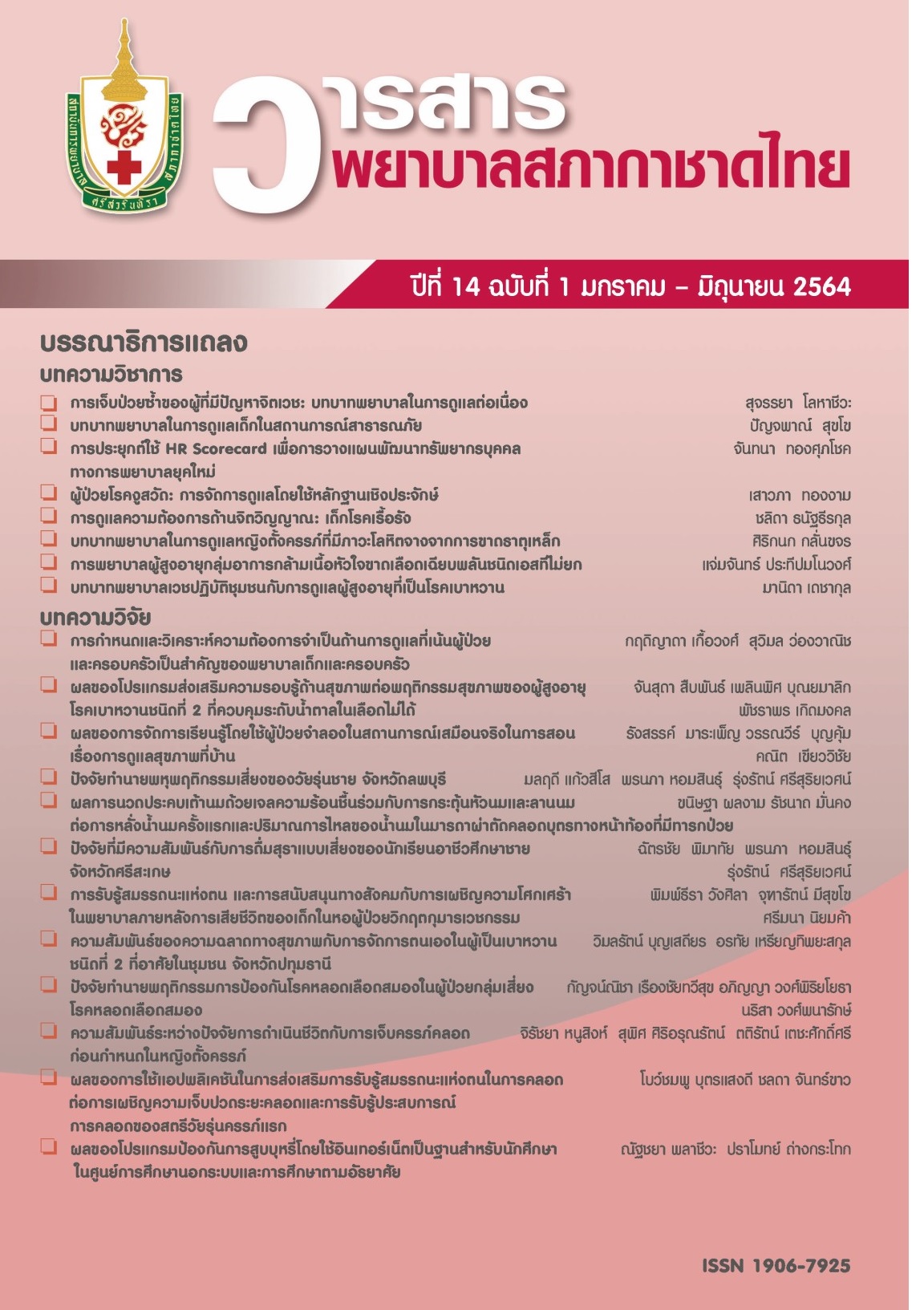Effect of a Learning Instructional by Using Standardized Patients as Simulation in Home Visits
Keywords:
learning management, standardized patient, simulation in home visitAbstract
The objective of quasi-experimental was effect of learning instructional by using standardized patients as simulation in home visits. The participants consisted of 48 nursing students in the 3rd year. The study was conducted from January-December 2019. The intervention was the standardized patients as simulation in home visits. The data was collected by using a knowledge questionnaire, skills at home nursing practice, confidence in the nursing home operation, and satisfaction of learning management questionnaires. Sandardized patients were used in virtual situations. The data was analyzed by using statistical percentage, mean, standard deviation and T test. Results of the study found that the average post achievement score (x̄ = 12.56, SD = 2.14) was higher than the pre-test (x̄ = 10.83, SD = 2.18). The skills at home nursing practice was at 75 percent, the mean of confidence in the nursing home operation was at a high level (x̄ = 4.04, SD= 0.49), and the satisfaction with the learning management by using standardized patients as simulation in home visits showed a high-level mean (x̄ = 4.34, SD= 0.62).
In conclusion, learning management by using standardized patients as simulation in home visits could be implemented for greater learning outcomes, self-confidence and satisfaction of nursing students.
References
2. Office of the Education Council: ONEC. Education in Thailand 2018. Bangkok: Prik Wan Graphic; 2018. (in Thai)
3. Kumkong M, Chaikongkia P. High-fidelity simulation-based learning: a method to develop nursing competency. The Southern College Network Journal of Nursing and Public Health 2017;4(Suppl.):332-44. (in Thai)
4. Duangkamon N. Simulation based learning for nursing education. Journal of Boromarajonani College of Nursing, Bangkok 2016;(31)3:112-22. (in Thai)
5. Cordeau MA. Teaching holistic nursing using clinical simulation: A pedagogical essay. J Nurs Educ Pract 2013;3(4):40-50.
6. Phrampus PE, O'Donnell JM. Debriefing using a structured and supported approach. In: Levine AI, DeMaria S, Schwartz AD, Sim AJ, editors. The comprehensive textbook of healthcare simulation. New York: Springer; 2013. p.73-120.
7. Kim-Godwin YS, Livsey KR, Ezzell D, Highsmith C. Home visit simulation using a standardized patient. Clin Simul Nurs 2013;9(2):e55-e61.
8. Kanhadilok S, Punsumreung T. Simulation based learning: design for nursing education. Journal of Nursing and Education 2016;9(1):1-14. (in Thai)
9. Kamanee T. The science of teaching: knowledge for effective learning management. 6th ed. Bangkok: Chulalongkorn University; 2007. (in Thai)
10. Keiser MM, Turkelson C. Using Students as standardized patients: development, implementation, and evaluation of a standardized patient training program. Clin Simul Nurs 2017;13(7):321-30.
11. Skinner HM. Simulation: preparing nursing students to work with community-dwelling older adults. Clin Simul Nurs 2017;13(10):520-3.
12. Kolb DA. Kolb learning cycle [Internet]. 1999 [cited 2019 18 Nov]. Available from: http://www.ldu.leeds.ac.uk/ldu/sddu_multimedia/images/kolb_cycle.gif
13. Jeffries PR. Simulation in nursing education from conceptualization to evaluation. 2nd ed. n.p: National Leaque for Nursing; 2012
14. Tantalanukul S, Rattanasak S, Sengpanich C, Srisung W, Tungkawanich T. The effect of simulation-based learning on the ability development of primary medical care practicum of nursing students at Boromarajonani College of Nursing Uttaradit. Boromarajonani College of Nursing, Uttaradit Journal 2016;8(1):49-58. (in Thai)
15. Bornais JA, Raiger JE, Krahn RE, El-Masri MM. Evaluating undergraduate nursing students' learning using standardized patients. J Prof Nurs 2012;28(5):291-6.
16. Samrannet W, Korissaranuphab N. Saisfaction of simulation-based learning in nursing care for patients with shock among nursing students in Srimahasarakharm Nursing College. Journal of Sakon Nakhon Hospital 2019;22(1):64-75. (in Thai)
17. Jamjang S, Yomdit V, Pongphetdit B, Pitaksin D, Changsieng P, Montong A. Effects of using simulation-based learning for preparation of nursing practicum on perceptions of self efficacy in performing nursing care in a hospital. Nursing Journal of the Ministry of Public Health 2017;27(Suppl.):46-58. (in Thai)
18. Bandura A. Self-efficacy: toward a unifying theory of behavioral change. Psycho Rev 1977;84(2):191-215.
19. Boonkerd M. Effects of using simulation based learning on self confidence and skills in taking nursing care of patients with crisis condition diversity in health and well-being. [Internet]. 2015 [cited 2019 Jun 10]. Available from:https://administer.pi.ac.th/uploads/eresearcher/ upload_doc/2015/proceeding/14443730 72220903004511.pdf
20. Sinthuchai S, Ubolwan K. Fidelity simulation based learning: implementation to learning and teaching management. Journal of The Royal Thai Army Nurses 2017;18(1):29-38. (in Thai)
21. Sittipakorn S, Kochamat A, Seubniam S, Pongprathet J, Chumpawadee U, Gawgleun W, Suriyan S, et al. Effects of high fidelity simulation based learning on self-confidence and satisfactions among the 3rd years nursing student in Faculty of Nursing Mahasarakham University. The 14th Mahasarakham University Reseach Confercnce. p. 600-9. (in Thai)
Downloads
Published
Issue
Section
License
เนื้อหาบทความหรือข้อคิดเห็นต่างๆ ในวารสารพยาบาลสภากาชาดไทยนี้ เป็นความคิดเห็นของผู้เขียนบทความ ไม่ใช่ความเห็นของกองบรรณาธิการ หรือสถาบันการพยาบาลศรีสวรินทิรา สภากาชาดไทย






